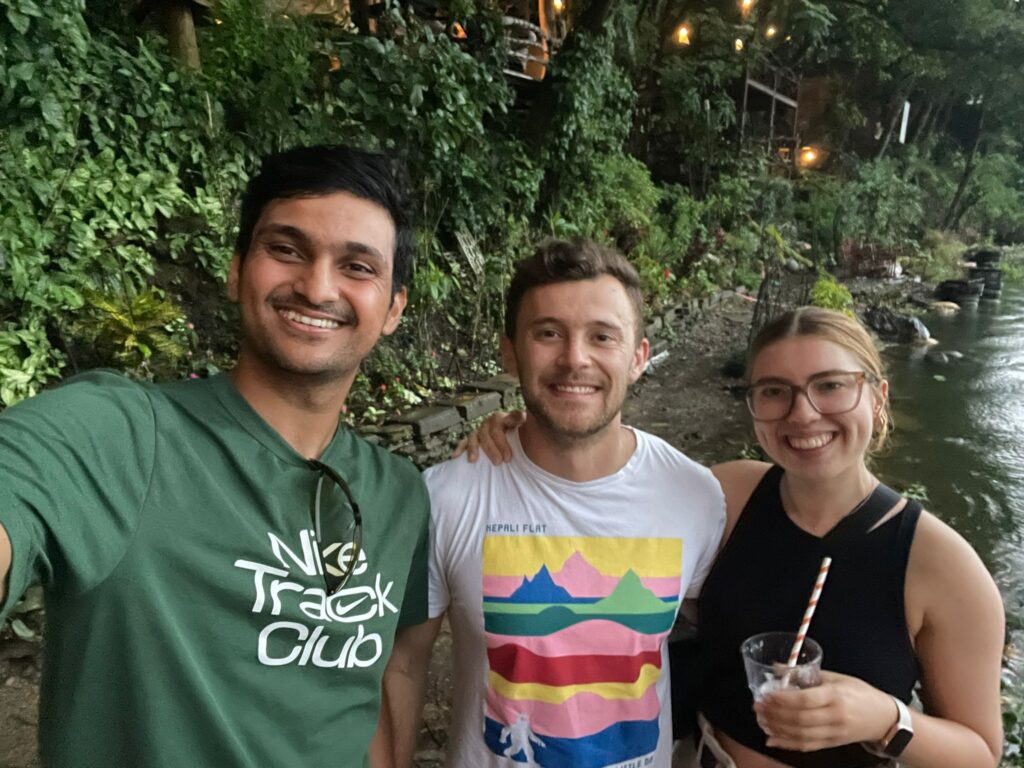After hours of walking through lush forests, across suspension bridges, and along winding mountain paths, I found myself completely immersed in the natural world of the Himalayas.
One of my bucket list goals this year was to do two multi-day treks. I’ve always loved the mountains, but I also love staying connected, and for the past four years, I hadn’t gone a single day without opening my laptop to check in on work.

I did the short Mt. Batur hike in Bali and completed the Stoos Ridge Trail in Switzerland this year, but I was craving a more extended adventure. The perfect opportunity came when I got the entire month of September off before transitioning to a new role (more on that later).
After doing my research, I chose the Annapurna Base Camp (ABC) Trek in Nepal. It was a spontaneous trip—I booked my flights just three days before departure and had no trekking gear with me. But that only added to the sense of adventure.
I completed the trek in five days, with the help of a porter guide. It turned out to be one of the most surreal experiences of my life. Walking for five to six hours each day, surrounded by snow-capped peaks and dense forests, I was fully immersed in the magic of the mountains.
Here are some observations I made on the trek.
In the mountains, time moves differently
“Time is relative” comes from Einstein’s Special Theory of Relativity, which states that the rate at which time passes depends on the observer’s frame of reference. It’s true in everyday life as well: when you’re having a good time, the hours fly by, but when you’re bored, they seem to drag on.
Time is either a constant, detached from us, or it can feel deeply connected to our experience.
Trekking feels like one of those activities where time bends. You walk for hours, your body may ache, but somehow it still feels like it passes so quickly.
Back in my hometown, even a 20-25 minute walk can sound exhausting. Most people would just take a cab or drive if it’s more than a 10-minute walk. But in the mountains, a two-hour trek between villages felt completely normal.
We’d start trekking at 8 AM and arrive at our destination by 2 or 3 PM, depending on how many breaks we took. And I loved that sense of time—it was freeing.

A little help goes a long way
Nepal recently banned solo trekking in most regions due to safety concerns, requiring hikers to have an authorized guide. However, this rule isn’t strictly enforced, so you could still trek to Everest or Annapurna base camp without one.
Having already completed a 3-day Poon Hill trek in December 2021 with a guide, I felt confident going alone. But on a whim, I inquired about a guide, and my agent recommended a porter guide—a sherpa who could act as both a guide and porter for the same cost. He didn’t speak much English, but he knew Hindi, and I decided to go for it. He would also handle the permits, allowing me to start trekking as soon as I reached Pokhara.
It turned out to be the best decision.

My rucksack was only 10kg, far from the 20kg he could carry, but the real value came in more than just lifting weight. After nearly forgetting how gruelling it is to carry 12-13 kgs while climbing endless stairs, I appreciated the help. The elevation gain from 1780m to 4130m was no joke, and the stairs were relentless.
Beyond that, he made sure I was doing okay, handled things at the tea houses, and was good company.
This trek became a balance of challenge and enjoyment, and it reminded me that sometimes, getting a little help—whether while traveling or in life—can take you farther than you think.
I need more activities where I don’t use my phone
Walking for hours was incredibly therapeutic. While I had my phone with me and used it often for pictures and videos during breaks, most of the trek was spent in silence—either focused on the muddy or slippery path beneath my feet or gazing at the stunning vistas when the trail leveled out.
And this went on for hours, every day.
In my normal life, most of my activities rely on technology, so this break was a refreshing change. It reminded me of my school days when I’d spend hours practicing basketball, completely immersed in the game without even thinking about checking a phone—because we didn’t have them.
I don’t have a problem with technology; it simplifies my life in countless ways. But I do crave moments away from it, where I can dive into something without the urge to check my phone, or even think about it.
Running felt similar earlier this year when I was training for a half marathon, but even then, I used my phone for Strava, Spotify, Audible, and constantly checking my stats mid-run.
It’s time to ditch the phone more often.
Friendships happen when you least expect them
I didn’t set out on this trek to make friends, though I figured I’d meet a few interesting people along the way, as usual. Most of these interactions are brief—just a quick chat during lunch or exchanging stories over dinner.
For the first four days, that’s exactly what happened. I had short conversations with people whose names I didn’t even catch.
Then, on the fourth day, I briefly met an Australian guy who I assumed was trekking alone. At the next stop, I ran into him again, this time with his partner and their guide and porter. We walked together for a while during what turned out to be the longest day of the trek—descending 27.5 km. Exhausted, they kept pushing on while our guides arranged for us to share a private jeep back to Pokhara the next day.
The following morning, we continued descending together, chatting all the way down. Ed and Cyanne were from Sydney, so we quickly connected, exchanging travel stories and reminiscing about my time in Australia.
What started as a casual walk turned into a full day of hanging out. The next day, we took a yoga class, had breakfast, got massages, and watched a storm roll in from a lakeside café. Time passed effortlessly, and before I knew it, I had spent the whole day with them.
I originally planned to spend my time in Pokhara catching up on emails and relaxing solo, but this spontaneous friendship was so much more fun and valuable. We even met up again in Kathmandu before I flew back to India.
Sometimes, the best friendships happen when you least expect them.

Life is like a river
“But out of all secrets of the river, he today only saw one, this one touched his soul. He saw: this water ran and ran, incessantly it ran, and was nevertheless always there, was always at all times the same and yet new in every moment! Great be he who would grasp this, understand this!”
Herman Hesse,
In Siddhartha by Herman Hesse, much of the story’s final wisdom comes from the river, where Siddhartha learns profound lessons about life’s flow and the nature of time.
While I won’t dive deeply into those lessons, I couldn’t help but feel a similar sense of reflection during my trek along the Modi Kola river. For five days, I crossed bridges and streams, with the river flowing thunderously beside me.
As we approached Annapurna Base Camp, the river ran to our left, concealed by mist. At ABC, I walked up to overlook what seemed like the very source of the river—this powerful yet ever-changing force of nature.
It struck me that, much like Siddhartha’s river, the one I followed wasn’t the same at any given moment. It was always flowing, always changing, just like we do.
That’s when the concept of impermanence really hit home. The river never stops, and neither do we. I wasn’t the same person at the end of the hike as I was at the beginning. My thoughts, my body, my reality—they were all in motion, constantly evolving.
Accepting this impermanence isn’t easy, but spending time in nature, or challenging myself with experiences like this trek, helps me get closer to that peace.

This trek was more than just a physical journey; it was a chance to disconnect, reflect, and observe life from a new perspective.
Thanks for reading and coming along for this journey with me.
Logistics
I won’t dive too deep into the logistics, but here’s a quick overview if you’re planning to do the ABC trek:
- Flew from Delhi to Kathmandu, then to Pokhara on the same day. Flying is considered risky, but I’d take a 30-minute flight over a 10-hour bus ride any day.
- Arranged my porter through Tenpa Sicho via Instagram. Paid $25 USD per day, all-inclusive.
- Trekking permits for Indians cost 1,500 NPR (~$11 USD).
- It was supposed to be a 6-day trek, but we finished in 5.
- Expect to spend around $30-40 USD per day on meals and accommodation. I got private rooms, but during peak season, you might have to share.
- Mobile network works well until MBC, not at ABC. WiFi is available at ABC. Use Nepal Telecom for coverage.

Route Details:
Day 1: Jeep from Pokhara to Jhinu Danda. Trek from Jhinu Danda to Lower Sinuwa, with lunch at Chhomrong.
Day 2: Trek from Lower Sinuwa to Deurali. Originally planned to stay at Dovan, but pushed on since we reached early. Lunch at Himalaya—great cafés with proper coffee.
Day 3: Trek from Deurali to ABC. Took it slow in case of AMS, but felt fine. Very foggy after MBC; couldn’t see much at ABC. Should’ve spent more time at MBC to enjoy views of Machapuchare.
Day 4: Foggy sunrise at ABC; still couldn’t see much. Trek from ABC to Lower Sinuwa, with lunch at Dovan. This was the most exhausting day—downhill trekking is tougher than uphill.
Day 5: Trek from Lower Sinuwa to Jhinu Danda, with breakfast at Chhomrong. Jeep back to Pokhara.



Pingback: A Solitary Birthday in Malaysia - Ayush Jain